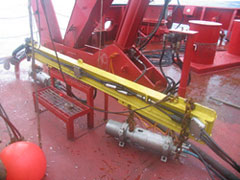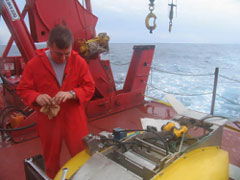

 | |||||||||||||
|
|
Journals 2005/2006Susan Holt
May 10, 2005 This is our first day in the Indian Ocean. We are traveling in rough weather with storms around us, so the ship was pitching all night. I am on the top bunk in a room I share with a biologist from France, Joelle Galeron. We were able to talk today and I enjoyed hearing about her career and experiences. Being in such a small room, it is a relief that I have a roommate who is easygoing and patient in explaining undersea vents to me. Hopefully, I will be able to see the pictures that her team will be seeing with the Remotely Operated Vehicle (ROV). When I got up this morning, the TV crew was already up, even after they were up so late last night! The geophysics team is going to use me to help monitor equipment, so they took me on a tour this morning. The "barn" is a special container on the back deck that has electricity, intranet, air-conditioning and much more. When you step inside, work stations are set up with computers and monitors and other equipment. One side of the container is for the geophysicists and the other is for the biologists. The area has very high ceilings with winches for lifting heavy equipment inside. We then went outside where the equipment on the back deck is tied down. There is a steel beam with cables for compressed air and a trigger attached to two airguns. The airguns are attached by thick chain links to the I-beam. In the middle of the deck is an instrument called a Sidescan, which the scientists are not sure they are going to use because of the extra time it would take. An instrument called a HUNTEC, which is named for the company that makes it, is secured on the back, as well. It was explained to me that a HUNTEC is older technology, but very useful. The HUNTEC is towed about 150m to 300 m below the ocean. From what I understand, it has two means of delivering sound, either by the boomer, which is a steel plate hitting another steel plate, that creates a sound that bounces off the seafloor and back to hydrophones that pick up the sound, and a sparker, which is high voltage electricity that triggers a lower frequency sound. Sound typically travels through salt water at about 1500 m/s. These sounds will bounce off the seafloor and then up to the hydrophones in a long cable that is "streaming" off the back of the ship from the crane. The signal then goes to computers, which record the signal to give the scientists an idea of the structure of the seafloor. This data will provide a signal that can be used by the visualization team to create a model of the ocean floor.
Daily science meetings started today, with the introduction of the project's name: Sumatra Earthquake and Tsunami Offshore Survey (SEATOS 2005). We learned of our shift assignments and other organizational information. I am going to be helping the geophysics team and biology team on the noon to midnight shift. We are steaming to the first site and equipment will not be deployed until 1-4 in the morning. Once the HUNTEC and/or airguns are deployed, the ship will slow down. We will tow the equipment in a straight line to get baseline data to the first site. |
||||||||||||

